What is the best cheap HDR monitor?
HDR monitors provide a top-quality image, rich blacks, vivid whites and bright colors. They are perfect for open-world games and are direct rivals to Adobe RGB monitors.
HDR enhances the contrast between light and dark areas, improves the lighting, creates bright colors and makes them seem more similar to how you see colors in life.This technology is widely used in the best Samsung monitors.
HDR is not a temporary trend like stereoscopic 3D was and it is very important for making game graphics look like in real life. This is something that the industry has been trying to achieve for more than ten years.
You can’t get a monitor that offers HDR along with a refresh rate of 240Hz and response time of 1ms because today only TN panels support that type of performance.
We have collected the best HDR monitors, tested and reviewed them to simplify your search. No matter if you like Control or Red Dead Redemption, here you’ll find a suitable computer for your needs.
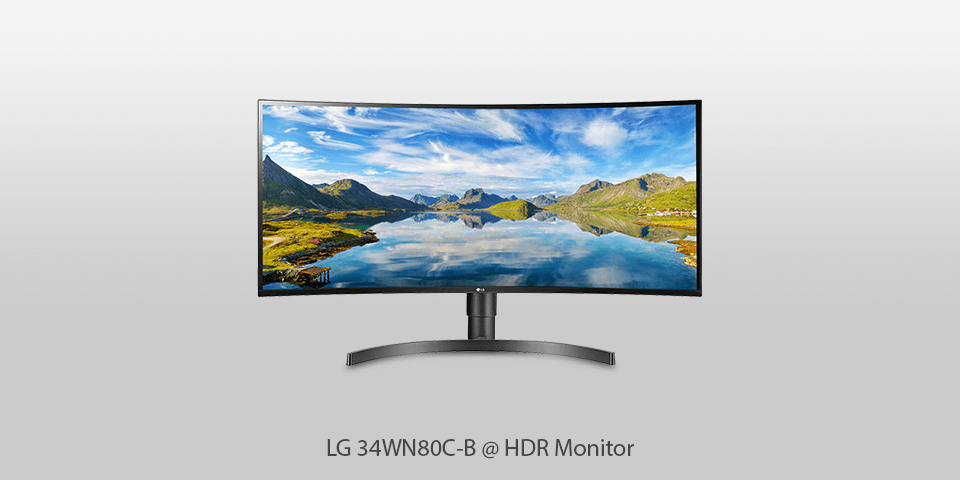
Screen size: 34-inch | Aspect ratio: 21:9 | Resolution: 3440 x 1440 pixels | Brightness: 300cd/m2 | Refresh rate: 60Hz | Response time: 5 ms | Viewing angle: 178 degrees | Contrast ratio: 2400:1 | Color support: sRGB
⊕ Ultra-wide curved screen
⊕ Trim frames
⊕ A refresh rate of 60Hz with AMD FreeSync
⊕ You can adjust height and tilt
⊖ Not very powerful gaming modes
⊖ Lack of built-in speakers
LG 34WN80C is an ultra-wide curved IPS monitor. Its large screen is perfect for work and gaming and you can bring it closer or farther by using a monitor riser. The sophisticated curve of the monitor creates an immersive effect while playing.
This HDR gaming monitor has a smart design with UltraWide Quad Definition (WQHD 3440 x 1440), great quality of image and video and makes your games look realistic.
Also, if you need multi-tasking, the 34-inch screen, 21: 9 aspect ratio and the Screen Split 2. 0 feature will help you easily view and work with documents and sources.
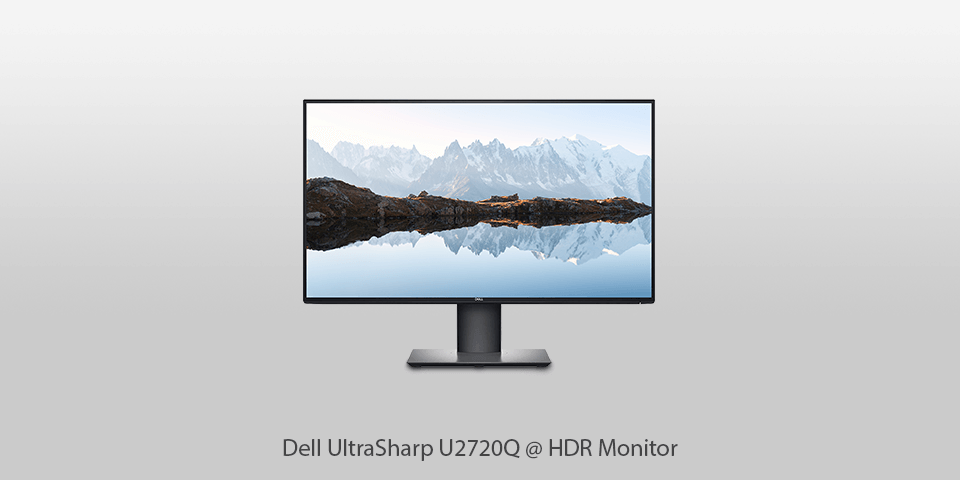
Screen size: 27-inch | Aspect ratio: 19:9 | Resolution: 3840 x 2160 pixels | Brightness: 350cd/m2 | Refresh rate: 60Hz | Response time: 8ms | Viewing angle: 178 degree | Contrast ratio: 1300:1 | Color support: sRGB
⊕ Wide viewing angles
⊕ The stand is easy to adjust
⊕ Excellent gradient handling
⊕ Top-quality materials
⊖ Bad HDR performance
⊖ Poor black uniformity and visible backlight bleed
Dell U2718Q is a great 4k IPS monitor. Like the majority of Dell monitors, it has great ergonomics, so you will easily adjust it to a necessary viewing position.
However, even though it’s an HDR monitor, this doesn't change much, since it can't display a wide color gamut and has a low contrast ratio. That’s why blacks look gray in darkness.
This monitor provides color coverage with 95% DCI-P3 which covers about 25% more color space than sRGB and guarantees more precise color reproduction. Dell U2718Q also offers 99% sRGB and 99% Rec. 709 color coverage. See more Adobe RGB monitors.
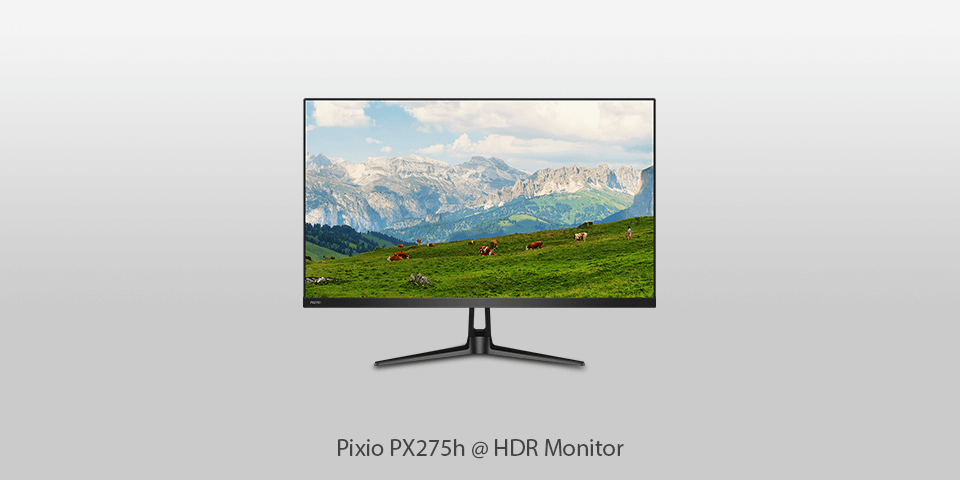
Screen size: 27-inch | Aspect ratio: 16:9 | Resolution: 2560 x 1440| Brightness: 350 cd/m2 | Refresh rate: 95Hz | Response time: 4ms | Viewing angle: 178 | Contrast ratio: 1000:1 | Color support: sRGB
⊕ Affordable price
⊕ More than 60Hz
⊕ Supports Freesync/GSync
⊕ AMD FreeSync 2
⊖ You can change only tilt
⊖ HDR only via HDMI 2.0
Since the PX275h 27" is a gaming monitor, it will impress you with a great visual experience. I tested this HDR monitor for a week and used it to play and work. Besides, I have watched several HDR films on this screen.
The gaming capabilities of this monitor are incredible. First of all, FreeSync will provide you with a smooth gaming experience without any tearing. If you have a good graphics card then refresh rates can go up to 144Hz. FreeSync technology, 2K resolution, excellent performance and graphics card make this model great.
You can connect various devices to this 2K HDR monitor via DisplayPort 1.2, HDMI 1.4, HDMI 2.0, headphones jack, audio line-out for the 2×3 built-in speakers, and a USB port to update the firmware. Note, to get HDR you must use the HDMI 2.0.
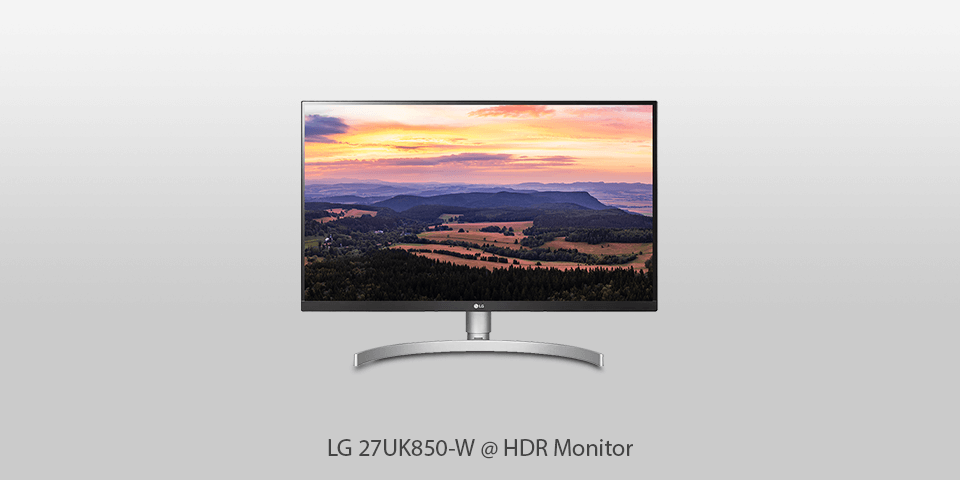
Screen size: 27-inch | Aspect ratio: 16:9 | Resolution: 3840 x 2160 | Brightness: 450 cd/m2 | Refresh rate: 60Hz | Response time: 5ms | Viewing angle: 178 degree | Contrast ratio: 1000:1 | Color support: sRGB
⊕ Universal design
⊕ Virtually frameless
⊕ Very easy setup
⊕ Supports 4K resolution
⊖ Expensive
⊖ Refresh limit of 60Hz
LG monitors are famous for their nice aesthetics and 27UK850-W is not an exception. It has a 27-inch UHD (3,840-by-2,160) panel which is enclosed in a frameless white cabinet with black trim.
There is a stand that supports the cabinet. This stand consists of a curved metal bar and a telescopic arm for height, tilt, and pivot adjustment.
This HDR monitor has a 10-bit panel, which covers 99 percent of the sRGB color gamut, provides a 350cd/m2 peak brightness, a 16:9 aspect ratio, a refresh rate of 60Hz, and a 5-millisecond (gray-to-gray) pixel response rate.
For a normal price, this $500 monitor performs on the same level as other Ultra HD displays in our review. It provides great gaming performance and precise color calibration.
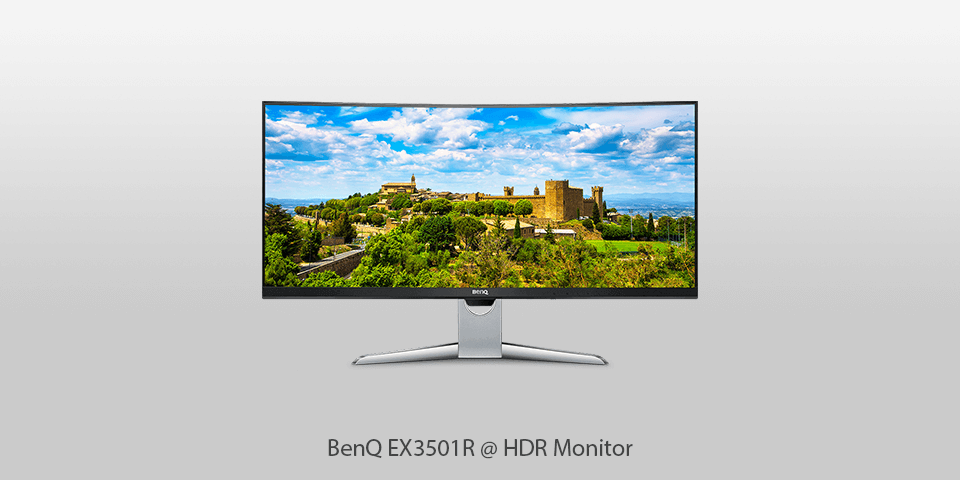
Screen size: 35-inch | Aspect ratio: 21:9 | Resolution: 3440x1440| Brightness: 350cd/m2 | Refresh rate: 100Hz | Response time: 4ms | Viewing angle: / | Contrast ratio: 2500:1 | Color support: sRGB
⊕ Support for HDR content
⊕ A refresh rate of 100Hz
⊕ Great color
⊕ FreeSync technology
⊖ No built-in speakers
⊖ Lack of swivel adjustment
⊖ Ports aren’t visible
BenQ EX3501R is the newest 35-inch, ultra-wide HDR monitor. It’s suitable for entertainment and in the marketing material focuses on a panoramic 21:9 aspect ratio and HDR (High Dynamic Range) eye-care features.
This monitor boasts 'Opt-clarity' technology which combines HDR support with 'Brightness Intelligence Plus" (B.I.+). This will help enhance the viewer experience, make bright areas soft and dark areas sharp even in a poorly lit room.

Screen size: 27-inch | Aspect ratio: 16:9 | Resolution: 3840 x 2160 | Brightness: 300cd/m2 | Refresh rate: 60Hz | Response time: 5ms | Viewing angle: 178 | Contrast ratio: 1000:1 | Color support: sRGB
⊕ Good performance
⊕ Top-quality image
⊕ Colors are natural and rich
⊖ Not higher than 60Hz
⊖ Only stand’s tilt can be changed
This is an affordable 4K HDR monitor with an IPS panel. It provides rich, bright colors, supports FreeSync for smooth operation and includes other useful features.
This gaming monitor from a world-famous brand has an aspect ratio of 16: 9 and is compatible with FreeSync technology. It is based on an IPS panel that allows you to get incredibly bright colors and wide viewing angles.
I will also note the high color accuracy thanks to the factory color calibration. This 4K HDR gaming monitor boasts a 300 cd/m² brightness rating, a 3840 x 2160 4K UHD resolution, 1.07 billion colors, and 1000: 1 static contrast ratio.
You get a smooth gaming experience without ghosting, stuttering, and tearing due to FreeSync. Connectivity options include DisplayPort, HDMI, and a few others. You can adjust the tilt of the monitor for more visual comfort.
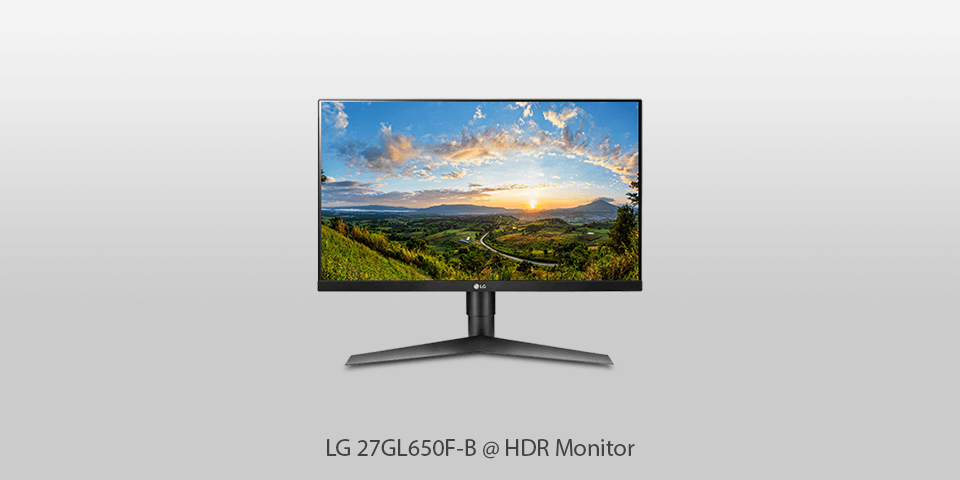
Screen size: 27-inch | Aspect ratio: 16:9 | Resolution: 1920x1080 | Brightness: 400cd/m2 | Refresh rate: 144Hz | Response time: 5ms | Viewing angle: 178 | Contrast ratio: 1000:1 | Color support: sRGB
⊕ Amazing response time
⊕ Peak brightness is awesome
⊕ Perfect accuracy
⊕ 144Hz
⊖ Contrast ratio could be better
The design resembles that of the LG 27 bezel less monitor, but this model is fitted with more powerful components. Since it has a low input lag and wonderful motion handling, this screen is great for gaming. It can also be a nice option for offices thanks to its decent ergonomics, good reflection handling, and amazing viewing angles.
However, if you are interested in a good multitasking monitor, you should look at the other models. 27GL650F-B has a low native resolution and is not ideal for working in dark rooms.
If you're satisfied with pixels on the screen, then you can get this 144Hz Free Sync monitor with G-Sync technology for just $200. 1ms motion blur reduction, excellent ergonomics adjustments (you can modify height, pivot, or tilt) and HDR10 support are the strengths of this monitor.
1080P isn't good enough for a screen of this size. However, if you find a 4K monitor with a higher resolution for that money, it probably doesn't have high refresh rates, G-Sync/Free Sync support, or other specs important to gamers.
| Image | Name | Features | |
|---|---|---|---|
 |
LG 34WN80C-B
PROFESSIONALS |
CHECK PRICE → | |
 |
Dell UltraSharp U2720Q
PHOGRAPHERS |
CHECK PRICE → | |
 |
Pixio PX275h
GAMERS |
CHECK PRICE → |
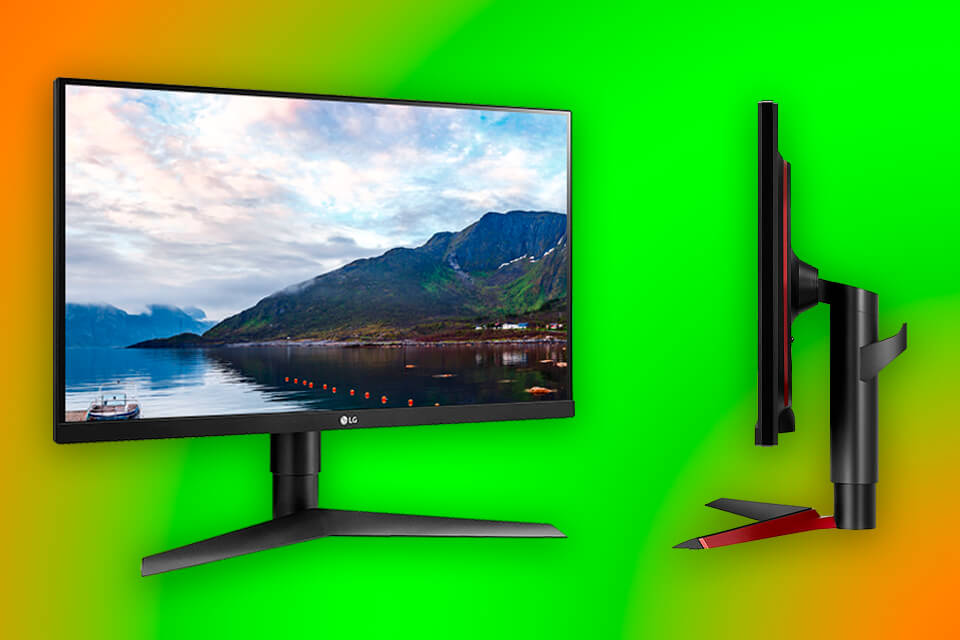
Monitors with HDR support are some of the key components for natural-looking images. This monitor type is interesting for movie fans, gamers, and people whose work is connected with various creative tasks.
Here are a few key points to keep in mind when choosing an HDR monitor:
A good HDR computer monitor can significantly outperform its SDR opponent in brightness. If you need a monitor for general use, then a minimum max brightness of 500 nits will be enough for you (choose DisplayHDR 500 or higher).
If you are planning to dip into the world of games, then you should pay attention to DisplayHDR 600 or higher. Retouchers and video editors should consider options starting with DisplayHDR 1000 and choose this monitor for photo editing and post production.
Pay special attention to the backlight dimming type. You can get monitors with FALD, edge-lit dimming, and global dimming. Starting from DisplayHDR 500 you can expect edge-lit dimming. If we talk about full array local dimming (FALD) or edge-lit dimming, then more zones are preferable.You can easily find a good HDR monitor under 200 bucks nowadays.
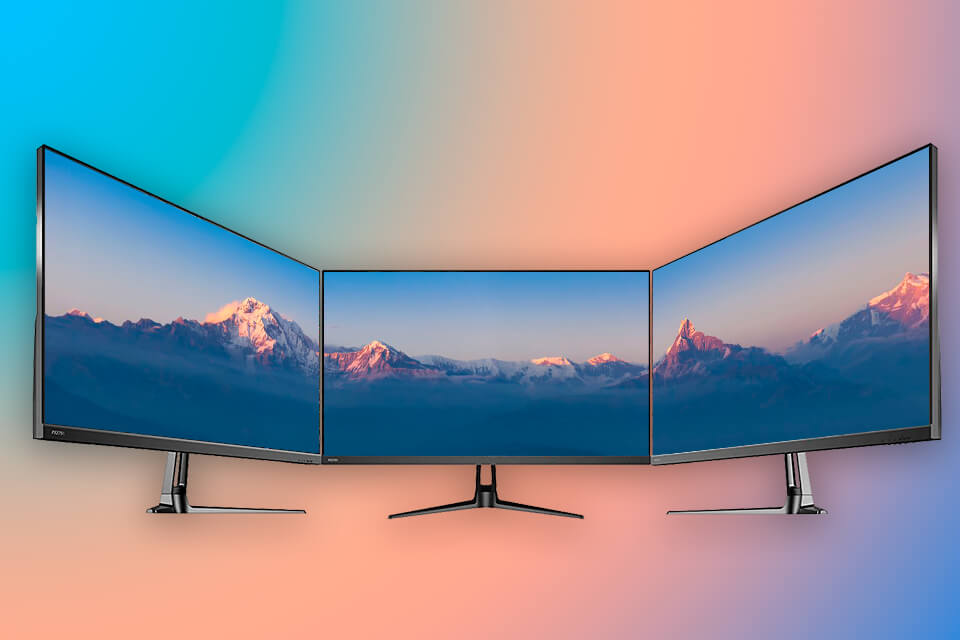
Choose an HDR PC monitor with higher DCI-P3 coverage. Moreover, it is a good idea to learn more about color accuracy. High contrast shows the advantage of HDR display over its SDR counterpart in the best way. So, try to buy monitors with higher contrast ratios.
A low response time is crucial for gaming on an HDR monitor. Look for monitors with a response time of 5ms or less to reduce motion blur and ghosting, especially in fast-paced games.
Ensure that the monitor has the necessary ports to connect to your devices. HDMI 2.0 or later and DisplayPort 1.4 are typically required for HDR content. Also, check if your graphics card supports the required HDR standards.
There are different HDR standards, such as HDR10, Dolby Vision, and HLG (Hybrid Log-Gamma). Ensure that the monitor supports the HDR standard that is compatible with your content sources. HDR10 is a widely adopted standard and is supported by most HDR content.
High Dynamic Range (abbreviated HDR) is a color technology that allows a screen to display a huge range of contrasts and colors. An HDR monitor delivers a more realistic picture with great detail and different color and tone variations.
Of course, yes, if you are a graphic artist and need to have the most realistic and accurate colors. HDR technology is supported by almost all top-class monitors as well as many mid-range models. However, you must be careful as some games and TN panels are not compatible with HDR.
HDR WQHD (2560 x 1440) includes IPS glossy with Dolby Vision, 500 nits. See more 1440p QHD monitors.
While HDR rendering appeared a long time ago, HDR presentation is an innovative technology that allows screens to display more colors and shades. Since many games are already internally developed with HDR, using an HDR monitor will not degrade its performance.
When purchasing an HDR monitor, look for a high peak brightness level, typically measured in nits, as it allows for vibrant highlights in HDR content. Additionally, ensure that the monitor supports a wide color gamut, such as DCI-P3 or Adobe RGB, to accurately reproduce a broader range of colors. Lastly, consider if the monitor incorporates local dimming or zone dimming technology, as it enhances contrast and improves the display's ability to render deep blacks and bright whites for a more immersive HDR experience.
No, all HDR monitors are not created equal, and there are indeed different levels of HDR performance to consider. HDR performance can vary based on factors such as peak brightness, color gamut coverage, local dimming capabilities, and HDR certification standards. Monitors that meet higher HDR standards, such as HDR10, HDR10+, or Dolby Vision, tend to offer a more immersive HDR experience with enhanced brightness, contrast, and color accuracy.

 Rating
Rating